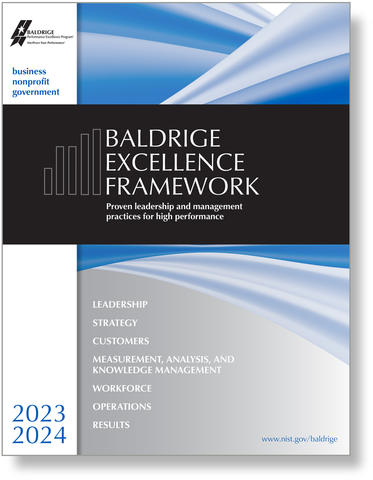Blogrige
The Official Baldrige Blog

Did you know that the most recent revisions (2021-2022 and 2023-2024) of the Baldrige Criteria for Performance Excellence® (part of the Baldrige Excellence Framework® booklets) have added specific assessment questions related to cultural diversity, equity, inclusion, and accessibility (DEIA)? More important, would you like to learn how to use the Baldrige framework to address DEIA in your workforce and improve your organization’s results?
If so, you may benefit from information shared in a recent webinar produced by the Association of Manufacturing Excellence (AME) in collaboration with the Virginia-based Senate Productivity and Quality Award (SPQA)—a member of the Alliance for Performance Excellence (the nonprofit network of regional and state-level, Baldrige-based award programs across the nation). The virtual training was presented by Lisa Tabor from CultureBrokers, LLC, a company that works with organizations to help them improve equity—which the company defines as “performance results that do not vary across racial and ethnic groups.”
Tabor described her organization’s approach as addressing the role of diversity (defined as “difference”), inclusiveness (defined as “behavior,” in particular, how people interact and work independently to achieve equity), and discipline (defined as “the systems, frameworks, policies, practices, processes, and built environments that impact equity as an outcome”). “Discipline is the key that is needed to get to … equity results,” she noted. “So we’re leveraging … the power of those influences to then develop a system that generates equity results.”
This approach, she added, “is very similar to how Baldrige … applies its framework … The Baldrige framework now is about that rigor, that discipline. … It has evolved to be … more clear about the role of diversity, inclusion, and equity in performance improvement and ultimately in … performance excellence.”
Focus on Structure
Tabor emphasized the importance of “leveraging your structure to improve your culture,” that is, “the policy and practices … the built environment.”
According to Tabor, to improve DEIA, most organizations initially focus on individual influences, for example, providing training on better understanding other groups of people in the workplace. Organizations then move on to work on social influences, Tabor added, such as building groups of people to support each other in improving DEIA, for example, through book clubs.
“But the improvement can’t stop there,” she said, stressing the need to also address influences on individuals from the structure of the organization. “[Addressing] that structural influence helps to … further accelerate the improvement … and actually is really critical to sustaining and stabilizing that improvement once it’s made,” she said.
The Baldrige Framework’s Evolving DEIA Criteria
Tabor highlighted how the Baldrige framework is a tool that can help organizations look at their structural influences on DEIA in their culture so that negative influences can be removed. “Baldrige is a … framework that talks about functions … that interact with different stakeholder groups; functions that leaders … perform; functions that are related to clients or customers; functions that are related to your workforce; functions related to measurement, knowledge management, and results.” She called the Baldrige framework a very good way to approach improvement in structure.
“Baldrige is a really great framework for teasing apart your organization, identifying its key systems, determining whether those systems are getting the results that you are trying to get or say are important, and then using that to diagnose improvements that you can make,” said Tabor.
She then highlighted the areas within the Criteria that address DEIA. Those include the sections on new workforce members, workforce benefits and policies, and organizational culture (within category 5), as well as the workforce results section (within category 7).
In the newly released 2023-2024 Baldrige Excellence Framework®, Criteria questions from those sections relevant to DEIA include the following:
- New Workforce Members: How do you ensure that your workforce represents the diversity of ideas, cultures, and thinking in your hiring and customer communities?
- Workforce Benefits and Policies: How do your policies related to compensation address fairness, and how do your benefits address the needs of a diverse workforce and different workforce groups and segments?
- Organizational Culture: How do you ensure that [your organizational culture] supports your mission, vision, and values; promotes empowerment, equity, and inclusion; and benefits from the diversity of ideas, cultures, and thinking of your workforce?
- Workforce Results: How do these results [for workforce capability and capacity, workforce climate, workforce engagement and retention, and workforce development] differ by the diversity of your workforce and by your workforce groups and segments, as appropriate?
What Works: Tips and Steps
After providing two examples of client organizations she has seen significantly improve (performance/ results) by addressing DEIA, Tabor shared the following tips based on their success:
- Make a public commitment.
- Involve everyone.
- Leverage structure.
- Be disciplined.
- Show results.
She also shared six steps of a successful approach based on the organizations’ experiences:
- Assess your situation using DEIA-specific data and information.
- Identify areas of strength, weakness, and opportunity for cultural diversity, inclusiveness, and equity.
- Decide on a few, high-impact strategic improvements. (Tabor stressed this point, mentioning that the two organizations she spotlighted had focused on just three improvements they wished to make at the time.)
- Identify, assets, relationships, and internal resources.
- Identify strategy entry points and concrete next steps.
- Assign accountability and responsibility.
“It’s all about the progress, so do what you need to do, make an effort, learn from that, and keep moving on,” Tabor concluded. “This is a journey for everyone, and we’re all learning. And I’m constantly learning, too.”
“Baldrige also helps you with … understanding [your organization’s] maturity—on that journey,” she added. “So you will in fact go through improvements that are about first having an approach, then deploying that, learning from it, and then [advancing to] the highest level, which is integration.”

2023–2024 Baldrige Excellence Framework®
The Baldrige Excellence Framework has empowered organizations to accomplish their missions, improve results, and become more competitive. It includes the Criteria for Performance Excellence, core values and concepts, and guidelines for evaluating your processes and results.
Purchase your copy today!
Available versions: Business/Nonprofit, Education and Health Care available mid-February





